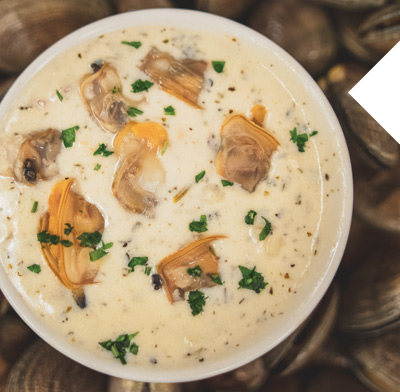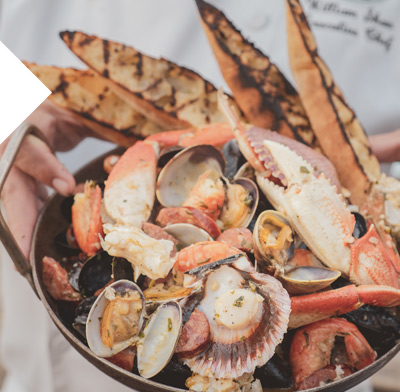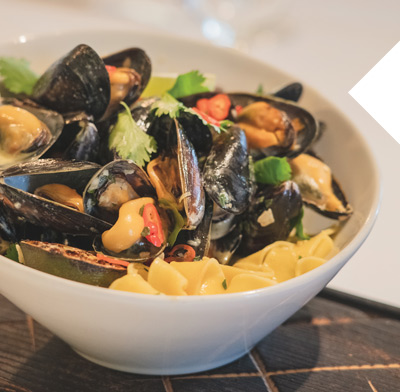As the sounds of the cannon fire and taps signal the lowering of Roche Harbor’s flags of during our last colors ceremony of the summer, we say goodbye to our guests, seasonal staff, and all the warm memories that made for a great summer in the San Juans.
The days are shorter and the nights are a little colder, but for me, October is my favorite month of all. Things slow down a bit and allow me to reflect on the menus of the summer and look forward to savory stews, braised lamb shanks, roasted winter squashes, and the comfort foods we all enjoy.
I recently headed out the door at sunrise to the calming sound of a distant foghorn, my drive to work less than calm as I navigated through the thick fog and startled deer to Roche Harbor. On my way into work, I stopped at Westcott Bay Shellfish to pick up some clams and oysters for the evening service. Westcott Bay grows Manila clams or Japanese littleneck clams, which migrated here on bottoms of sailing ships amongst the barnacles and mussels. These chubby little clams are known for their meat-to-shell ratio, tender bite, and sweet taste. They make a perfect steamed clam with butter, fresh herbs, garlic, and white wine; and when making chowder, these are the only clams you should use.
I have always known that the Northwest is a great place to grow shellfish, but it wasn’t until I visited Europe on my 50th birthday with my wife Rose that I realized that the Puget Sound is the shellfish basket of the world. I was amazed how frequently our shellfish farms appeared on menus in Europe.
This month I wanted to explore these famous little mollusks and share a few recipes that you can enjoy with your friends and family while cruising, tied up to the dock, or at home by a warm fire.

|
Roche Harbor Clam ChowderWhen I first arrived a Roche Harbor, the Dungeness Bisque was the only soup we served. The pictured clam chowder recipe, added in 1994, was inspired by the fresh herbs we were getting from Nootka Rose Farm on Waldron Island and, of course, the fresh Manila clams from our neighbor Westcott Bay Shellfish. I prefer to use fresh herbs, but dry herbs can be substituted with decreasing the recipe amount by half. Have fun with this recipe by adding fresh salmon, spot prawns, and Dungeness crab for an amazing seafood chowder, best served with warm crusty sourdough bread. Serves 6 (12-ounce servings)
Directions: In a saucepan, bring 1 quart of water to boil and add red potatoes. Reduce heat to bring potatoes to a slow rolling boil. Remove from heat when potatoes are firm to the bite without any crunch. Set aside. Heat a 4-quart heavy bottom sauce pan over medium-high heat, add bacon and cook until 50 percent of bacon fat is rendered, then add butter. When butter is melted, add celery, onion, and garlic. Continue cooking and stirring until the vegetables are cooked al dente. Add half and half, black pepper, white pepper, basil, marjoram, dill, thyme, and bay leaf. Continue stirring chowder and slowly bring the temperature up to 185 degrees, then add cooked potatoes, chopped clams, whole clams, and parsley. Reduce heat and hold chowder at 140 degrees until ready to serve. |
Northwest Steam Pot with
|

|

|
Thai Green Curry MusselsI must admit that I prefer mussels to clams and always have. Mussels grow everywhere along the coast, they require little effort to collect, no purging is necessary, they are naturally tender, and they are simply delicious. That being said, I have tried for the past 25 years to serve them on Roche Harbor menus and they will not sell with the exception of a few like-minded individuals. Guests will ask, “Can I have the green curry mussels but substitute clams,” or “I’d like the steam pot but could you leave out the mussels and give me extra clams?” Did I tell you that mussels are also gluten free? Ok, maybe I have taken this a little too far, but please give mussels a try. This recipe is one of my favorites and yes, you can substitute clams!
Directions: Heat oil in large pan or stockpot over medium-high heat. Add oil and onion, continue to sauté until onions are soft. Add garlic, ginger, and chili and cook for a minute. Add curry paste, lime zest, and fish sauce; cook while stirring until well combined. Add coconut milk and reduce heat to a simmer. Heat comfort level – taste sauce at this point. The sauce should be slightly spicy hot at your first taste but then level off. Add more curry paste to your liking. Add the mussels and stir to combine the flavors before closing the lid tightly. Cook for 8 to 10 minutes until all the mussels open. Stir mussels gently in pot to cover in sauce. Pour curried mussels into a large serving bowl and garnish with lime wedge and fresh cilantro leaves. Can be served as a main course with rice or noodles. Chef’s Note: Choosing mussels. Most mussels are farmed sustainably, making them an excellent choice. Penn Cove is the most famous in our area, and you can see their trucks all over I-5 each morning as they fill the refrigerators of seafood restaurants in your area. Penn Cove sells mussels to grocery stores without beards and are the easiest to deal with. The beard is a fibrous growth that comes out of their shells and helps them attach to shoreline rocks, pilings, and my skiff. If you cannot find them without their beards, no worries, they are easy to remove. Simply grasp the little beard in one hand and the mussel in the other and pull the beard off toward the hinge. Then take a green kitchen scrubby and buff off the remaining fibers under cold running water. |


